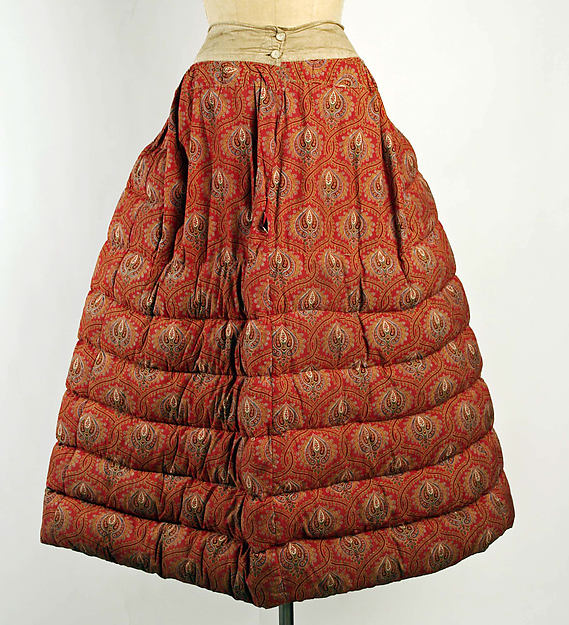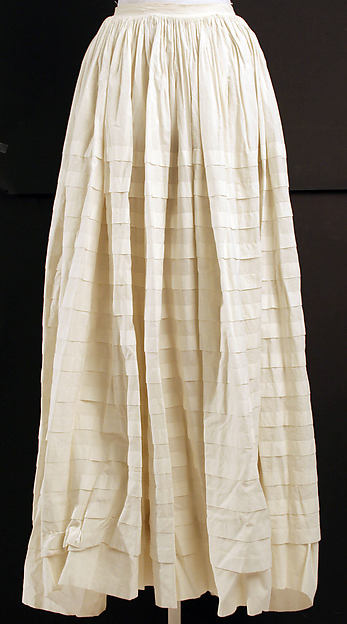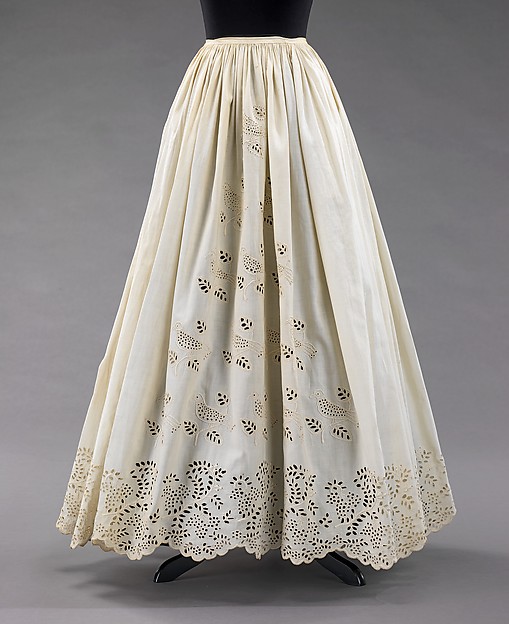Petticoats are worn under the dress for the sake of warmth, and also to make the gown hang more gracefully upon the person. They should have three or three and a half breadths of material in the width, and the bottom is made with a broad hem three nails [6.75 inches] deep, or with tucks or worked muslin. The latter is extremely neat. They are to be set on to a strong band or stock, and are to have a slit left at the back about four nails [9 inches] in length. The skirt may be gathered full all around, or only at the back and front, leaving the sides plain: sometimes all the fullness is thrown to the back. Having shoulder-straps to keep up the petticoats, is a great advantage; but they are unnecessary if a waist or body, with or without sleeves, be set on the band.
--The Ladies' Work-table Book (1850, 3rd ed.)
Unfortunately, everyone seemed to have known how to make petticoats during the mid-19th century. Excepting the above description, plain-sewing books tend to skip over the subject, save for infant petticoats and the occasional flannel garment; meanwhile, the magazines only mention embellishment options. Some
construction details are published around 1864/5, as the new gored skirts require a more
tapered petticoat.
 |
Braidwork and broderie anglaise petticoat insertion.
Godey's, 1861 |
Fortunately, surviving petticoats are available for study (even if many of them are the more embellished examples of their type).
The Girls' Own Toymaker (1860) also includes instructions for making flannel, hooped, and white petticoats for one's doll; at the time, this activity was viewed as
practical education, as well as play.
 |
(Somewhat exaggerated) hoop, with a petticoat underneath
Punch, August 23, 1856 |
Petticoats or underskirts are worn above the skirt supports--hoop, corded petticoat or crinoline [horsehair] petticoat--smoothing the line of the dress. One or more may also be worn below, for warmth and to guard against wardrobe mishaps (drawers duplicate these functions). A
silk underskirt, worn over the hoop, will keep a light-weight muslin dress looking crisp and neat.
White cotton (or linen) petticoats have the same washing/bleaching benefits as white chemises or drawers. As noted before, white embroidery, tucks, and sturdy lace (including certain
knit "laces") will hold up to laundry better than more delicate trims, and are thus the preferred means of decorating washable white garments. Around 1864/5, the use of
colored wool braid, specifically black and red, on white petticoats becomes fashionable, though readers are advised to use color-fast trims. For inclement weather,
dark petticoats won't show dirt as badly.
Petticoat hems may be beautifully decorated for ones' own enjoyment, and also in case they ever comes into view; around 1861, the fashion will change in favor of embellished insertions rather than edgings. Decoration along a front panel is also possible, and much desired when worn with
open-front wrappers or morning gowns.
 |
Peterson's, February 1859
The broderie anglaise petticoat (above) may have been made
for wearing with an open-front wrapper such as this. |
 |
This warm post-war (c. 1865-70) petticoat contains down.
From The Met. |
Flannel was a favorite material for the lowest petticoat, particularly in cold weather. Children's could even be layered with a
knit or
crocheted petticoat for extra warmth. Quilted and wadded petticoats, as well as
"alpaca" and wool ones, are also options in cold weather.
On the other hand, a brightly-colored wool "Balmoral" petticoat, worn as the outermost layer, is intentionally visible below skirts which have been raised for walking.
 |
The "Highland" walking dress, with Balmoral skirt.
"With this dress a Balmoral skirt is indispensable.
Some ladies make the petticoat of plain gray flannel,
and ornament it with rows of red cloth or flannel." |
You really need a petticoat when dressed for the mid-century, except in the very humblest of circumstances. Servants are
expected to wear them, even if
hooped or decorated ones are deemed inappropriate. Required clothing for female inmates at the
Illinois State Hospital for the Insane included "two woolen petticoats or skirts." [Edited to add: Liz has a
whole list of reasons, for those unpersuaded.]
As a final note, while your petticoats shouldn't generally be visible (excepting some morning and walking ensembles), it is perfectly period to remain calm and dignified if they are briefly in view:
"It does not alarm us nor shock us to see the flutter of a white petticoat or an embroidered skirt, but when such things make a show on the field it is a sure sign that the lady is not dressed right. " --Godey's, 1861












No comments:
Post a Comment